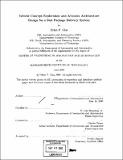| dc.contributor.advisor | R. John Hansman, Jr. and Charles Boppe. | en_US |
| dc.contributor.author | Glas, Dylan F. (Dylan Fairchild), 1975- | en_US |
| dc.contributor.other | Massachusetts Institute of Technology. Dept. of Aeronautics and Astronautics. | en_US |
| dc.date.accessioned | 2005-08-22T23:51:07Z | |
| dc.date.available | 2005-08-22T23:51:07Z | |
| dc.date.copyright | 2000 | en_US |
| dc.date.issued | 2000 | en_US |
| dc.identifier.uri | http://theses.mit.edu/Dienst/UI/2.0/Describe/0018.mit.theses%2f2000-30 | en_US |
| dc.identifier.uri | http://hdl.handle.net/1721.1/9253 | |
| dc.description | Thesis (M.Eng.)--Massachusetts Institute of Technology, Dept. of Aeronautics and Astronautics, 2000. | en_US |
| dc.description | Also available online at the MIT Theses Online homepage <http://thesis.mit.edu>. | en_US |
| dc.description | Includes bibliographical references (leaves 96-97). | en_US |
| dc.description.abstract | Fast Package Delivery was explored as a possible commercial application of advanced reusable launch vehicle technologies. The market was divided into two distinct segments: an on-demand charter service for urgent deliveries, and a scheduled service similar to today's overnight delivery services. System reliability is a strong driver for both cases. For the on-demand case, vehicle speed is of critical importance. In order to provide on-demand service, only one customer may be served per vehicle flight. Since the price a customer will pay is highly sensitive to vehicle speed, the optimal vehicle concept was determined to be a Mach 6 hypersonic aircraft. Due to the small payload weight (200 lb) the overall vehicle size and cost are highly sensitive to equipment weight. Therefore substantial savings could be realized if the aircraft were unmanned. Flight operations would most likely be autonomous during cruise, but remotely piloted during launch and landing. Scheduled service, due to its much larger projected payload (6000 lb), is less sensitive to the weight of onboard equipment, and would not need to be unmanned. Packages from many customers would be carried at once, enabling lower prices to be charged to each customer. Lower prices mean that lower vehicle speeds would be acceptable to the customers, and so the optimal vehicle concept for scheduled service was found to be a Mach 2-3 supersonic transport. Unfortunately, due to the inherent unreliability of experimental technologies, Fast Package Delivery does not appear to be a feasible application at this time. However, once supersonic and reusable launch vehicle technologies begin to mature, Fast Package Delivery should be considered as a realistic business prospect. This paper presents the market analysis, system requirements development, vehicle concept selection, and avionics considerations for a Fast Package Delivery system. | en_US |
| dc.description.statementofresponsibility | by Dylan F. Glas. | en_US |
| dc.format.extent | 97 leaves | en_US |
| dc.format.extent | 14091399 bytes | |
| dc.format.extent | 14091158 bytes | |
| dc.format.mimetype | application/pdf | |
| dc.format.mimetype | application/pdf | |
| dc.language.iso | eng | en_US |
| dc.publisher | Massachusetts Institute of Technology | en_US |
| dc.rights | M.I.T. theses are protected by copyright. They may be viewed from this source for any purpose, but reproduction or distribution in any format is prohibited without written permission. See provided URL for inquiries about permission. | en_US |
| dc.rights.uri | http://theses.mit.edu/Dienst/UI/2.0/Describe/0018.mit.theses%2f2000-30 | en_US |
| dc.rights.uri | http://dspace.mit.edu/handle/1721.1/7582 | |
| dc.subject | Aeronautics and Astronautics. | en_US |
| dc.title | Vehicle concept exploration and avionics architecture design for a fast package delivery system | en_US |
| dc.type | Thesis | en_US |
| dc.description.degree | M.Eng. | en_US |
| dc.contributor.department | Massachusetts Institute of Technology. Department of Aeronautics and Astronautics | |
| dc.identifier.oclc | 45537132 | en_US |
